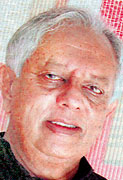Tilak Samarawickrema, versatile and receptive artist from Sri Lanka, was in Delhi in April exhibiting his intriguing wall hangings at Gallery Art Motif. A fortuitous meeting, courtesy an American art historian friend, Elizabeth Rogers, resulted in the discovery of a truly sensitive, concerned artist with a gentle sense of humour.
One discovered that there was more to the man; he had made witty animation films, done his Masters in Architecture from Rome in the early 1970s, and had since become a designer of buildings and factories that were eco-friendly and a pleasure to the eye, and of course a draughtsman with a sensual, singing line, a fact borne out by his lavishly illustrated biography. He came across as a modest man despite his many accomplishments.
 |
| Tilak Samarawickrema |
The mention of George Keyt, the master of line from Ceylon, as Sri Lanka was known then, who stayed in Rabindranath Tagore's haven for artists, Shantiniketan, during the poet's lifetime in the 1930s was a good conversation opener. Keyt, who always dressed in dhoti-kurta, drew with a sinuous, caressing line that was close to Picasso's when he drew his muse number three, Dora Marr.
Tilak quickly pointed out that Keyt ‘owed' Picasso for finding solutions to his plastic problems. He laughed heartily when told that Keyt had defended himself by saying that Picasso too owed a debt to the Old Masters, not the least Velasquez!
Samarawickrema uses the shadows cast by the thin wire scupltures imaginatively. Shadow and substance play off each other, corroborating each other's presence.
Tilak's playful, expressive line owes something to the curves in the Sinhala script. What had started as doodling in his student days became a passion by the time he went to Rome.
His exhibition of line drawings became a rage and then culminated in the warm, sensitive, humorous animation film on village life in Sri Lanka, Andare. It was a mature piece of work using motion sparingly and with wit and subtlety. This film was done in the old Cell Animation technique: 24 drawings were necessary to get a single second of motion. It was indeed a labour of love.
Both in terms of technique and aesthetics, it is a classical animation film and has an affinity with the glorious poetic works of Lotte Rhineger. Andare was shot with a bare minimum of means but has an elegance that stands out 33 years after its making.Elizabeth Rogers has called Tilak Samarawickrema “A Sri Lankan Aubrey Beardsley”, most probably because of his flowing line that verges on the decorative.
But unlike in the case of the Edwardian Englishman, Tilak's line has a latent power that allows it to change character. In other words, it is not just his signature but a versatile means of expressing seemingly disparate ideas. Being a product of his age, Tilak has allowed his graphic sensibilities to be influenced by the many humorous elements present in Dadaism and Surrealism. His drawings merit serious study by any connoisseur or student of art.
His integrated approach to all his activities – drawing, wire sculpting, animation film-making, toy designing, making wall hangings and practising architecture – gives his work a roundedness that is rarely seen these days. The one name that readily comes to mind is that of the great American designer and experimental film-maker Roy Eames, who visited India, and briefly the National Institute of Design, Ahmedabad, almost 40 years ago.
Tilak Samarawickrema has all along practised as an architect, and his design group, Tilak Samarawickrema Associates, is widely known and respected for its discerning work. His architectural sensibility, to be sure, is modern, but he has also learnt from classical architecture, especially that of Italy, which he studied in depth as a student there. His houses, for all their symmetry, also often contain a most pleasing asymmetrical element within. They are highly liveable spaces. Tilak's designs for factories are a model of social awareness combined with the need for sensible productivity. Indian factory designers could most profitably take a leaf out of Tilak's book.
He must have been widely liked, even loved, by his friends in Italy as well as those he made elsewhere in Europe and in New York because of an amiability that comes naturally to him and which is an expression of both his self-confidence and his good nature. His sparkling intelligence comes across in his drawings in the book, as does his slightly naughty sense of humour. His youthful eyes have in the photos the far-off look of a traveller, as they do even now, well over 40 years later.
He has the demeanour of a playful seeker. Like a restless child he must constantly be doing something and have his sense of curiosity challenged. Tilak Samarawickrema's work is a source of delight for all those who know it. |


